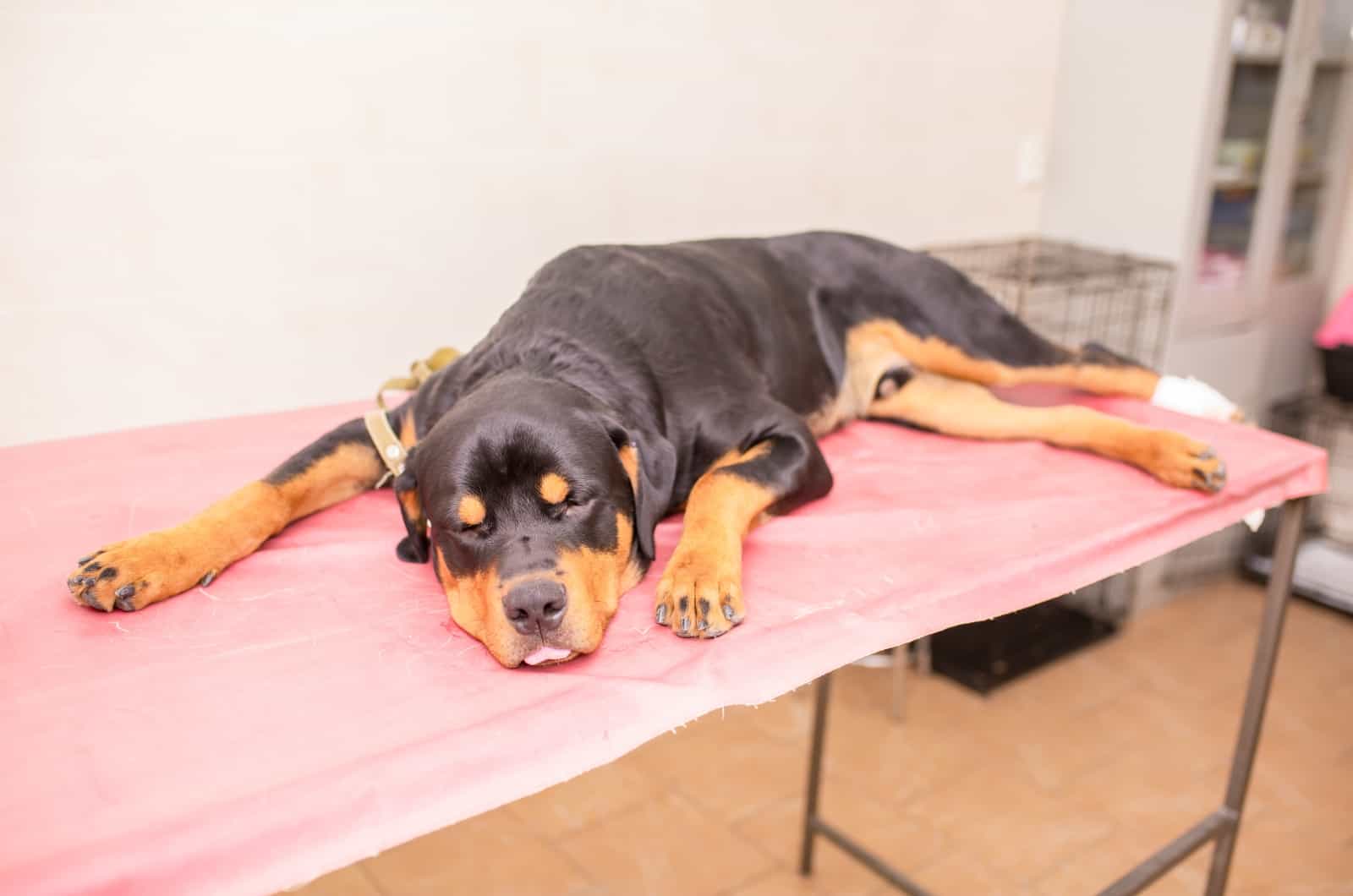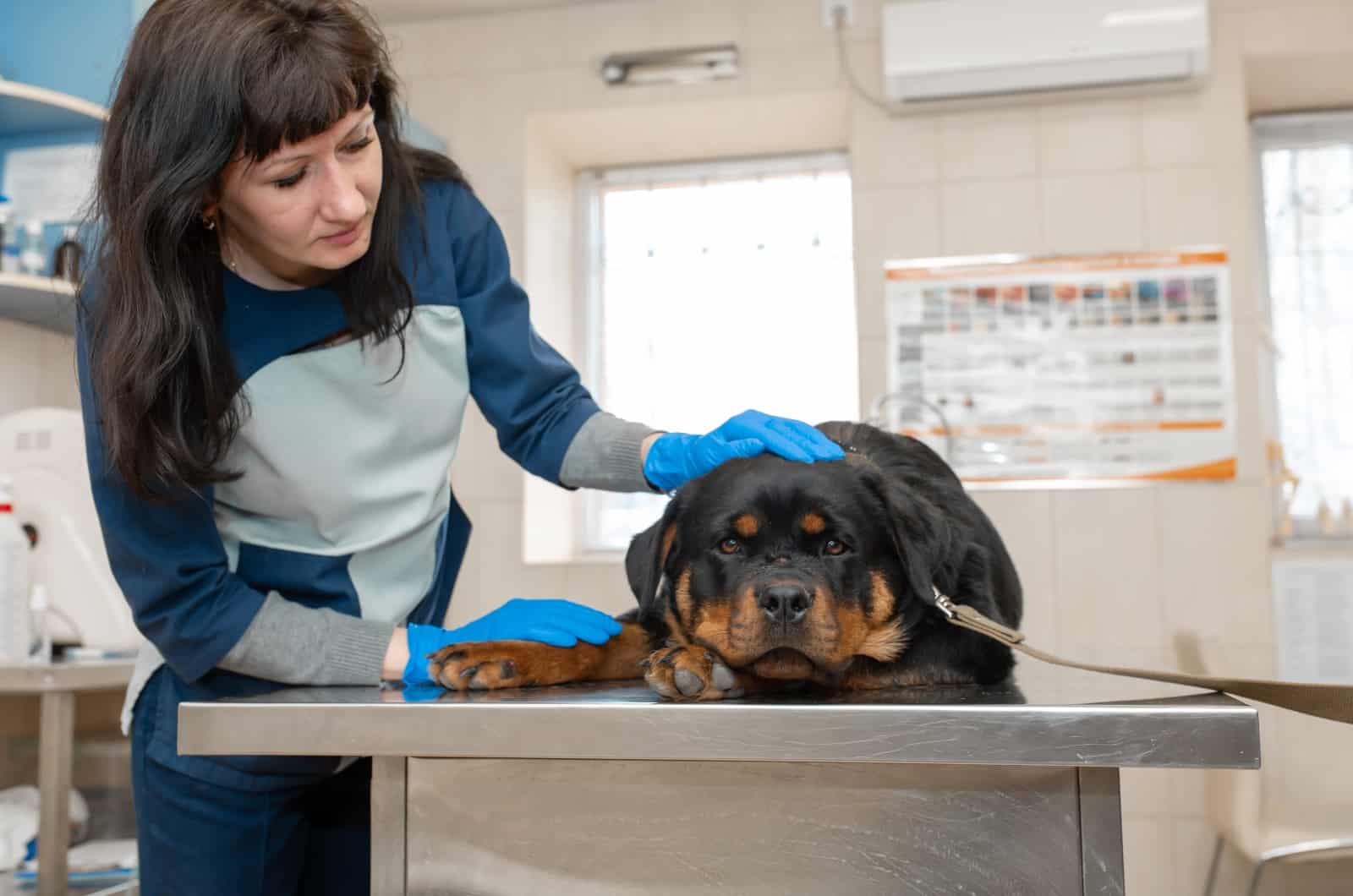Large dog breeds, like the mighty Rottie, are prone to conditions that affect their joints. Hip dysplasia in Rottweilers is relatively common, but the factors that determine whether your dog will have it are mostly external.
Being a hereditary genetic disease, it should not be taken lightly. Recognizing the symptoms on time is necessary to stop the progression, so we will go through all of them. If you were looking for answers on hip dysplasia in Rottweilers, this is the place to get them all.
We will start what it is, then proceed to explain how it manifests itself, treatment options and the recovery period. Stay glued to your screen for this one.
A Congenital Disease That Can Change Your Rottweiler’s Life

It is widely accepted that Rottweilers are among the best family dogs, with great guard dog instincts and surprisingly high tolerance of children and other animals. While this is the basis on which most owners choose their family pet, there are other important factors to consider.
One of the most overlooked aspects of purchasing a dog is health problems. Despite the imposing physique and remarkable temperament, there are several conditions that plague the Rottweiler breed specifically.
Perhaps the most frequent one is hip dysplasia. It comes as no surprise that the joints of a Rottweiler are probably their weakest point, considering their weight of over a hundred pounds.
Data from veterinary teaching hospitals in the United States shows that Rottweilers are the highest risk group for canine hip dysplasia, at a 35.4% incidence rate. The trend was present within the entire working group of dogs as well.
The nature of congenital diseases means it is present in the Rottie puppy from the fetal phase. Affected dogs are born with it, but the onset of symptoms does not appear until a few months of age. A diagnosis can be established in puppies aged between six and twelve months.
Note: Overfeeding a Rottweiler puppy will increase the risk of obesity, which in turn increases the risk of developing hip dysplasia due to excessive body weight. Use this Rottweiler feeding chart to stay within the recommended daily caloric limits.
What Does Hip Dysplasia Actually Mean?
In simple terms, it is an anatomical abnormality that is characterized by an improperly developed femoral head. With this deformity, the way the ball of the femur fits into the hip socket is faulty.
Usually, common conditions within a breed are not serious enough to lower the quality of life, but hip dysplasia has serious consequences if not treated in time. Then, what happens for hip dysplasia to develop to that stage?
While the imperfect fit of the hip joint leaves an empty space between the shallow socket and the femur head, the cartilage is the first structural and functional component that becomes damaged and ultimately destroyed.
Constant grinding and excessive pressure on it (the cartilage) puts more friction on the tissue, causing it to gradually wear out. Without the cushion it provides for the two bones, the bone tissue follows the same route of damage.
Any movement will extend the damage to the bone tissue, which will result in your Rottweiler developing osteoarthritis. This condition is essentially a chronic inflammation of the hip joint caused by damaged tissue.
Symptoms Of Hip Dysplasia In Rottweilers

As a joint problem, it is clear that the first and most common clinical sign has to do with your Rottweiler’s movement. Having trouble changing between standing and sitting and walking positions is one of the first symptoms.
Changes in gait, limping, or lameness are another three symptoms that fit the hip dysplasia diagnosis. However, it is important to get your dog to the veterinary as soon as you notice these clinical signs to rule out canine degenerative myelopathy, as they have similar symptoms.
If you suspect your Rottweiler has hip dysplasia, try listening for cracks and pops while the dog is moving. The lack of cartilage between the bones produces a clear, but disturbing sound.
With the progression of untreated hip dysplasia, you will start seeing definitive symptoms, such as the inability to stand, odd sitting positions, skipping a step, or dragging a leg.
Alongside difficulty moving, hip dysplasia in advanced stages causes a lot of pain. The condition itself does not cause it, but the arthritis does. This implies that the dysplasia has come to the point where the cartilage has already worn off.
Rotties that are in such pain and cannot properly stand or walk will struggle with getting on the sofa, climbing stairs, and even defecation or urination.
Diagnosing The Condition

There are a few tests a DVM will perform on your Rottweiler to confirm hip dysplasia. The first one is usually a radiograph of the hip. A radiograph is an X-ray of the joint that will show any deformities or abnormalities in bone and cartilage tissue.
Experienced veterinarians can do a palpation test to look for joint laxity (looseness). For this test your dog can remain awake, but for the radiograph general anesthesia is required for a clear image.
Rottweiler breeders in the US use the PennHIP radiography method to diagnose hip dysplasia in puppies. It has been developed at the University of Pennsylvania and the veterinarian performing it must be licensed by the university itself.
It involves putting the sedated puppy in specific positions under the X-ray to detect anatomical deformities that make the joint loose. The distraction or PennHIP view, the compression view, and the hip-extended view are then sent for evaluation.
With this method, puppies can be evaluated for hip dysplasia at sixteen weeks of age, allowing for the future owner(s) to discuss the best course of action with their veterinarian.
The second method, the OFA hip screening test, bases its radiograph positioning methods on recommendations set by the American Veterinary Medical Association (AVMA). The Orthopedic Foundation for Animals then interprets the scans and grades them according to the level of deformity.
Pregnant female Rottweilers or those in estrus should not be subjected to radiography. During estrus and pregnancy, the hormonal fluctuations can increase the looseness of the joints, thus giving false results. This is how you can tell whether your dog is pregnant or not.
Treatment Options

Bone and cartilage damage is hard to repair, which means the treatment options for advanced stages of hip dysplasia include only surgical procedures. Luckily, Rottweiler puppies that have been diagnosed early with the condition can have a simpler procedure with great results.
The pain that accompanies hip dysplasia, or rather osteoarthritis, can be managed by non-steroid anti-inflammatory drugs (NSAIDs). Some of those include Meloxicam and Galliprant.
It becomes more complex with long-term treatment, i.e., surgery. The younger the dog, the less damage was done to the hip joint and the bigger the chances of minimal loss of bone and joint mobility.
Surgical Methods
Puppies younger than 18 weeks with a hip dysplasia diagnosis can be treated using the Juvenile Pubic Symphysiodesis (JPS) procedure. This is the best option because it is not as invasive as the others and consists of closing a growth plate at the bottom of the pelvis.
Puppies are usually sent home the same day and the recovery period starts immediately. Strenuous physical activity is not recommended, as light walks on a leash have a beneficial effect without putting too much pressure on the hip joint.
For dogs between the ages of eight and ten months, the preferred surgical procedure is Double or Triple Pelvic Osteotomy (DPO or TPO). The pelvic bone is cut in two or three spots, with a rotation that ameliorates the femoral head coverage.
With implants, double pelvic osteotomy is used over TPO due to the less invasive nature of the procedure. It also speeds up the recovery time of the puppy patients.
If both JPS and DPO or TPO fail to treat the hip dysplasia, young dogs can have a Total Hip Replacement (THR). The best case scenario includes a spayed or neutered Rottweiler no younger than one year of age.
Essentially, the artificial hip joint replacement gives the Rottie better hip mobility and quality of life, as the full range of motion is achieved with a relatively short recovery period.
Femoral Head Ostectomy (FHO) is the last resort procedure, applicable to both young and adult dogs that are physically fit to successfully go through the recovery period. The removal of the femoral head, combined with stretched soft tissue, creates a “false joint”.
Still, FHO does not restore full hip joint function and mobility but provides pain relief. Fourteen days after the surgery, your Rottweiler will be able to start with physical activity with an NSAID therapy that approximately lasts for a month or two.
Your Rottie will require an E collar and regular cleaning of the wound. Do not let your dog remain unsupervised while the bandage or collar are off because licking the surgical site after the procedure can have bad consequences.
Cost Of Surgical Procedures
Managing the pain with NSAIDs is not expensive, but the long-term treatment can be costly. Juvenile Pubic Symphysiodesis costs around $800, Double or Triple Pelvic Osteotomy $3000, Total Hip Replacement $3500 to $7000, and Femoral Head Ostectomy about $2500.
As you can see, the more complex the procedure, the higher the price. Another problem with these procedures is the availability of qualified veterinary surgeons in your area. Travelling to another state for any of these procedures will incur additional costs.
Summary

While not fatal, hip dysplasia in Rottweilers can drastically reduce the quality of life. One of the biggest factor in avoiding it is the choice of breeder. Most reputable ones will perform PennHIP or OFA screenings to see whether a puppy is likely to develop the condition.
Additionally, the puppy parents undergo the same test and are not bred if hip dysplasia is diagnosed. Backyard breeders and puppy mills do not perform these tests and often knowingly breed and sell dogs with hip dysplasia and other genetic diseases.
Early detection is the first step to avoiding complications, high expenses, or seeing your Rottweiler suffer, so meticulously research the breeder before purchasing a puppy.
Read Next: Why Is My Rottweiler Panting So Much? 13 Common Causes
